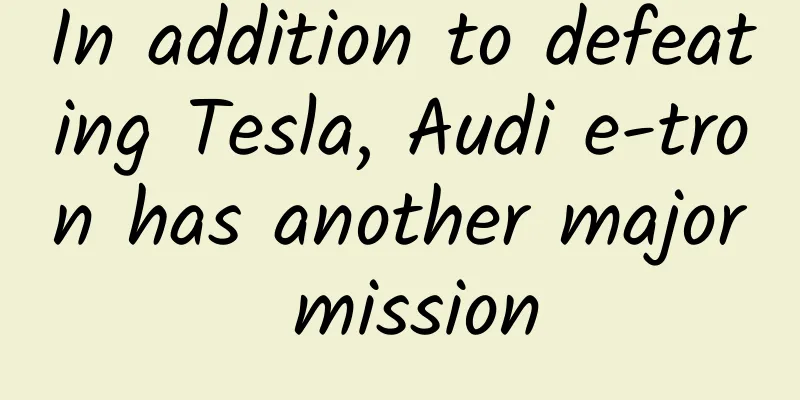In addition to defeating Tesla, Audi e-tron has another major mission

|
Starting with the e-tron, Audi's first electric SUV, Audi, which has always been known as a traditional luxury car brand, has a new rival - Tesla. Judging from the plans Audi has announced, Tesla is indeed a rival worthy of Audi's respect, but challenging it is not Audi's entire goal. Many signs indicate that as Audi moves towards a new era of EV, the role of e-tron is not just a new car, but more of a pioneer in building Audi's new EV system and a pioneering work in reshaping the high-end electric vehicle market. e-tron press conference Audi officially enters a new era of EV According to Audi's Roadmap E plan, by 2025, Audi will electrify its entire range of models and launch more than 20 electric vehicles, 12 of which are pure electric, with the goal of making electric vehicles account for more than one-third of its sales. It will invest in a total of 12 pure electric models in major global markets and strive to make pure electric models and plug-in hybrid models account for one-third of total sales. To achieve this goal, the Chinese market is a battleground. Audi China's general manager said that by 2025, Audi's sales target for plug-in hybrid and pure electric vehicles in China is 800,000 units. By 2022, Audi will have 10 electric models in the Chinese market, five of which will be produced in China. Audi e-tron In fact, Audi has been investing in new energy technologies for a long time. In the 1980s, Audi developed its own hybrid model, the Audi Duo. In 1997, the technologically mature Audi Duo III was launched on the market, becoming Europe's first mass-produced diesel hybrid model. You know, hybrid vehicles also need excellent electric drive systems. Traditional fuel vehicle manufacturers like Audi are the source of electric drive technology. The founder of AC Propulsion, the predecessor of Tesla, was an engineer who had participated in the GM EV-1 project. The appearance of Audi e-tron is a typical Audi family design, with a semi-enclosed active grille design on the front. Replacing the traditional rearview mirror with a camera can be seen as a major breakthrough. A 7-inch OLED screen is added near the inner handles of both sides of the door, which supports multiple viewing angles and zoom functions, and can also monitor blind spots. Of course, due to domestic regulations, this setting is unlikely to appear in domestic cars. Compared with the Tesla Model X, the Audi e-tron's 0-100km/h acceleration of 5.7 seconds is slightly inferior, but the e-tron's 95kWh lithium-ion battery pack has a range of 525km, which is better than the Model X 75D's 75kWh battery's 406km. In addition, the e-tron can be charged at Audi's self-built fast charging station with a power of 150kw, surpassing the 120kw of Tesla's super charging station, and the fast charging time only takes 30 to 40 minutes. In terms of price, the price of the purely imported e-tron in 2019 is expected to be around 750,000 yuan, and after domestic production in the second half of the year, the price is expected to fall in the range of 500,000 to 650,000 yuan. Compared with the starting price of 860,000 yuan for the Model X, it is very competitive. As Audi's first mass-produced pure electric SUV, the e-tron marks Audi's official entry into a new era of EVs. In the future, Audi's new energy vehicles will be based on four major platforms: the MEB platform, the MLP platform, the PPE platform, and the officially unnamed coupe electric platform for the production of the e-tron GT. Among them, MLP is dedicated to electric four-wheel drive, the electric vehicle platform PPE (Premium Platform Electric) developed in cooperation with Porsche focuses on high-end, and the MEB platform for A-class cars will develop special models for the Chinese market. In addition to products, Audi is also fully promoting the "360-degree charging" strategy, as the infrastructure for electric vehicles, the next generation of travel, is not yet complete. This model can not only provide users with one-stop home charging services, but also actively expand the cooperation of charging resources in public areas. It is reported that by the end of 2018, Audi's charging service will cover more than 120 cities and 80,000 charging piles; by 2019, Audi's home charging installation service will cover more than 200 cities across the country. Tesla's success is because it has captured the needs of high-income people and celebrities with environmental awareness to express their opinions on environmental issues. Audi also plays the environmental card in its publicity: Audi e-tron has an environmental protection system for the entire life cycle of the product; in the production stage, 95% of the energy in the carbon-neutral factory in Brussels, Belgium comes from renewable energy; in the use stage, the vehicle is driven by electricity and has zero emissions throughout the process; in the recycling stage, Audi provides a recycling plan for e-trons that have reached the end of their service life, reducing damage to the environment. Audi's factory in Brussels, Belgium Audi will take the lead in reshaping China's high-end electric vehicle market At present, in the pure electric SUV market, Mercedes-Benz and BMW, which are German luxury car brands BBA like Audi, have launched EQC and Vision iNext respectively. The three luxury brands will officially start a fierce competition in the field of electric vehicles. According to the plan, Mercedes-Benz EQC will be locally produced by Beijing Benz before the end of 2018 and sold in the Chinese market in the first half of 2019. BMW's iNEXT will be introduced to China after mass production in 2021. In comparison, Audi's localization time is more specific. Although BMW's iNEXT was launched later, it is expected to be equipped with BMW's fifth-generation electric system with an acceleration of 4 seconds per 100 kilometers and a range of 600km, and has L3-L4 level autonomous driving capabilities. After the launch of iNEXT, it will naturally become a strong rival to Audi e-tron. These three pure electric SUVs are just the first shots fired by the three major luxury car brands in the field of electric vehicles. Like Audi's e-tron, Mercedes-Benz plans to expand its electric brand EQ series. In addition to EQC, Mercedes-Benz has also registered EQA, EQB, EQS and other logos, which will correspond to the A-class, C-class and S-class of its own fuel vehicle series. By 2022, Mercedes-Benz's product line will be electrified, and each market segment will have at least one electric vehicle, with a total of no less than 10 pure electric vehicles. BMW also plans to launch 12 electric models by 2025, accounting for 15%-25% of the electric vehicle market. Currently, BMW's focus is on the development of the fifth-generation electric drive system and power batteries. Compared with Audi and Mercedes-Benz, BMW has actually made achievements in the electric vehicle business. BMW's electric vehicle sales exceeded 100,000 units in 2017 and are expected to reach 140,000 units in 2018. In the past, the three major luxury car brands BBA have been on the sidelines regarding the layout of electric vehicles because they were obsessed with their highly profitable traditional fuel vehicle business. Traditional car companies are unwilling to face the reality that electric vehicles will replace fuel vehicles as the next generation of transportation. In fact, power batteries do have obstacles such as low endurance, poor safety and lack of charging facilities. The development of electric vehicles in buses and taxis has not aroused enough vigilance for these giants, because in their view, the use of these commercial vehicles is basically fixed-time, fixed-point and fixed-quantity, and cannot represent the general passenger car market. Tesla Chairman Musk The above reasons have given Tesla ample development opportunities, and it has become an industry giant by taking advantage of the market window period. In China, companies such as BYD and BAIC New Energy have also achieved remarkable results by taking advantage of their own industrial chain or sales channels. Now, many new car-making forces driven by capital have also made plans after seeing the success of Tesla and domestic pioneers. Although NIO, WM Motors, and Xpeng Motors have completed the first batch of deliveries this year. Many policy and market factors ultimately caused traditional luxury car companies to change their views. However, the traditional fuel vehicle business is both their advantage and burden. Indeed, the lucrative fuel vehicle business can help them subsidize the electric vehicle business, thereby quickly seizing the market. But in terms of brand building, unlike Tesla, which has no historical baggage, the traditional fuel vehicle business may affect the creation of environmentally friendly brands by manufacturers such as Audi, which is also a problem that must be considered. If traditional luxury brands such as Audi can achieve a complete layout, then there will undoubtedly be another brand participating in the mid-to-high-end competition in China's new energy vehicle market, in addition to Tesla, which will take the lead in reshaping China's high-end electric vehicle market. The latest data shows that Tesla's sales in the Chinese market fell 37% year-on-year in the third quarter. For the ambitious Audi, now is indeed the best time to enter the market. As a winner of Toutiao's Qingyun Plan and Baijiahao's Bai+ Plan, the 2019 Baidu Digital Author of the Year, the Baijiahao's Most Popular Author in the Technology Field, the 2019 Sogou Technology and Culture Author, and the 2021 Baijiahao Quarterly Influential Creator, he has won many awards, including the 2013 Sohu Best Industry Media Person, the 2015 China New Media Entrepreneurship Competition Beijing Third Place, the 2015 Guangmang Experience Award, the 2015 China New Media Entrepreneurship Competition Finals Third Place, and the 2018 Baidu Dynamic Annual Powerful Celebrity. |
<<: What are the shortcomings of Chinese home appliances when competing with foreign oligarchs?
Recommend
What kind of wine is suitable for drinking in winter? What kind of wine should I give as a gift?
What kind of wine is suitable for winter? Drinkin...
17 major bonuses of new marketing in 2020!
In 2019, I saw a lot of interesting projects, coo...
How to leverage huge amounts of traffic from 0 to 1 quickly?
Qianchuan has integrated various e-commerce adver...
New car-making forces challenge the Shanghai Auto Show. What are their backgrounds?
Compared with previous years, one of the highligh...
"SEO Training Academy" Urumqi SEO shares how to increase SEO daily traffic from 0 to 10,000+
Nonsense: Time flies. I have been working in SEO ...
The peels of these 5 fruits are very nutritious, but you throw them away!
Do you usually peel the fruit before eating it? M...
If you don’t make good use of these 8 tools, you can’t be considered a good student!
01 Reading is the fastest, most effective and mos...
Guangzhou WeChat Mini Program Mall Ranking, What are the factors that affect the ranking of mini programs?
Open the APP on your phone, no matter which e-com...
Photography applet function diagram, how to develop the photography appointment function code of WeChat applet?
With the continuous development of the Internet, ...
These two male humpback whales, what are you doing | Nature Trumpet
Welcome to the 54th issue of the Nature Trumpet c...
Social e-commerce “business tips” on WeChat mini-programs!
There are three things in life that are intolerab...
Xiaomi's halo is fading: every phone sold loses money, and dealers are not enthusiastic
Xiaomi, which just celebrated its fifth birthday,...
Advanced ways to attract traffic to Douyin live streaming room
“If we want to increase the popularity of our liv...
Do plants know math? The magical Fibonacci sequence
Editor's note: Plants occupy a very important...
The formula for becoming a Tik Tok influencer worth $1 million!
Tik Tok has become more and more popular, and var...









